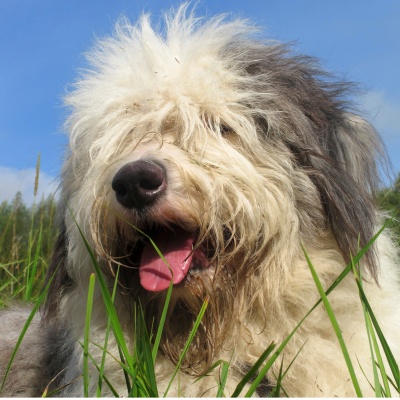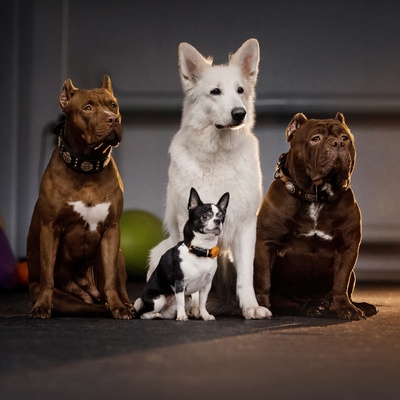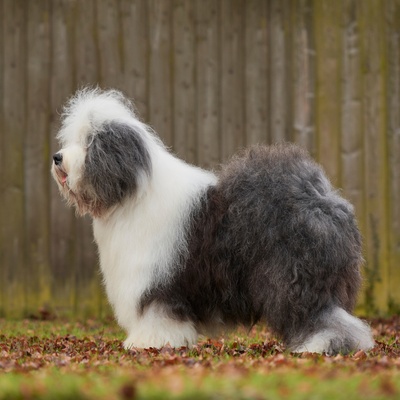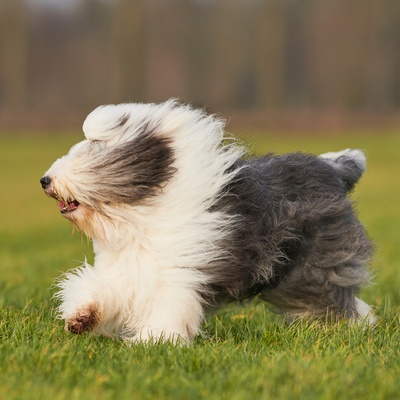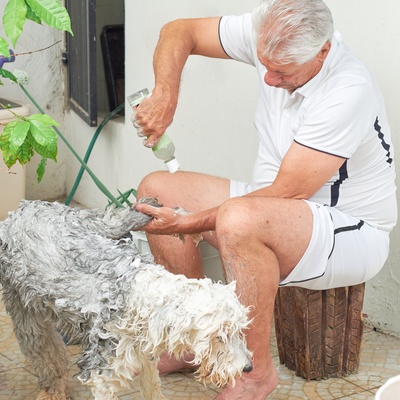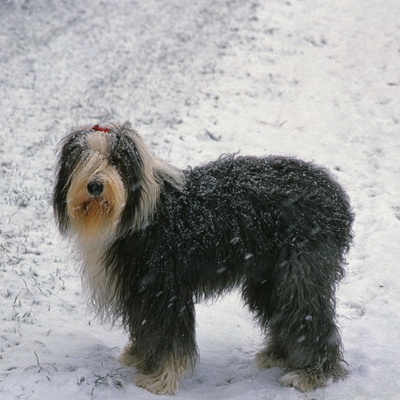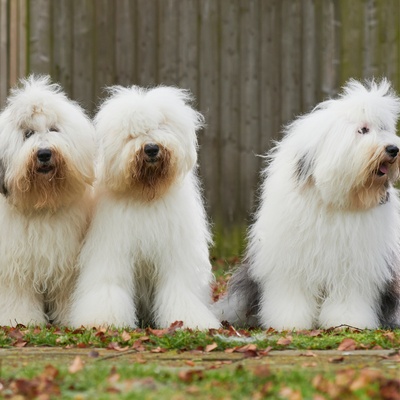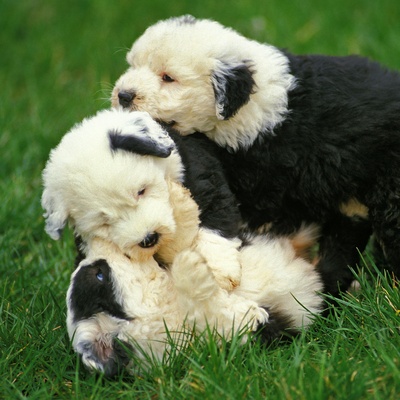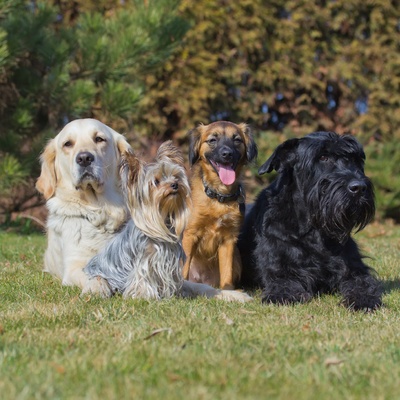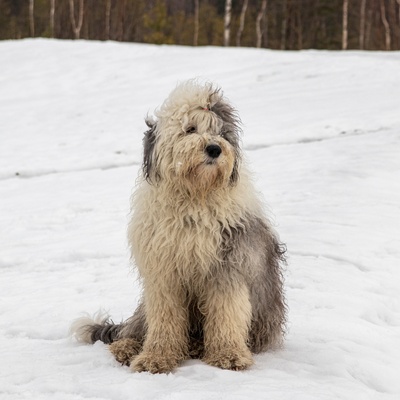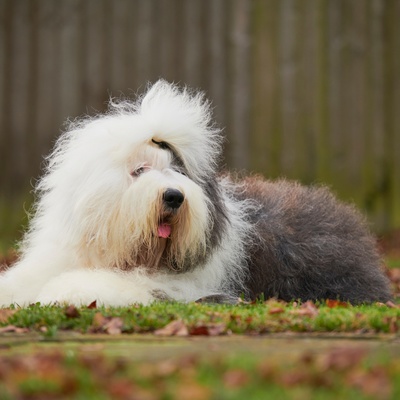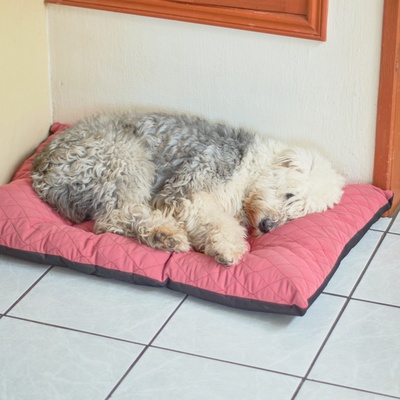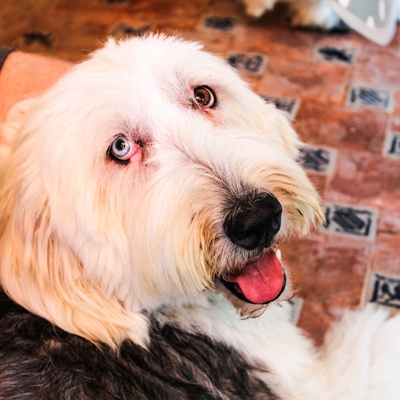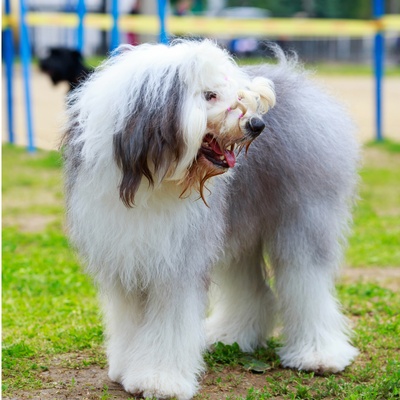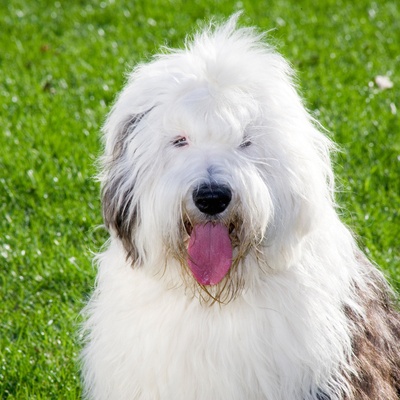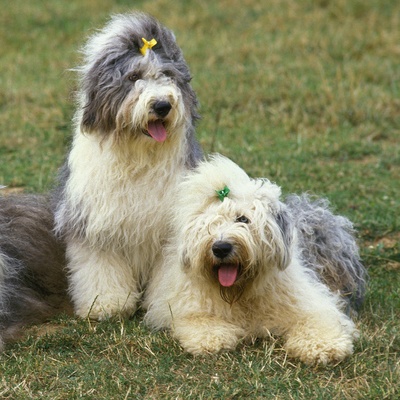Introducing the Old English Sheepdog
Discover all there is to know about the Old English Sheepdog : its characteristics, behavior, training, and its cost.
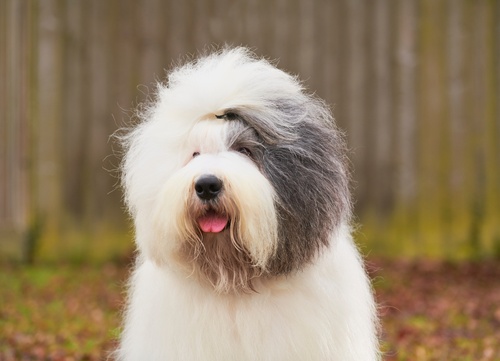
Discover all there is to know about the Old English Sheepdog : its characteristics, behavior, training, and its cost.
The Old English Sheepdog, known for its distinctive shaggy coat and amiable nature, has its roots deep in the pastoral landscapes of England. Known around the world for its affable nature, the Old English Sheepdog is more than just a pretty face with a distinctive bear-like shuffle. From serving as watchful companions to participating in dog sports such as agility and obedience, the Old English Sheepdog is a versatile breed capable of excelling in many areas.
Renowned for their loyalty and affectionate demeanor, they create deep bonds with their owners and are known for their sociable and loving nature. The Old English Sheepdog is famously good-natured and friendly, often greeting friends and strangers alike with enthusiastic displays of affection.
This section outlines the unique features of the Old English Sheepdog breed.
The Old English Sheepdog belongs to the Herding group (1). This category includes breeds known for their ability to control the movement of other animals.
The Old English Sheepdog is a large breed. They typically stand between 20 to 24 inches at the shoulder and usually weigh between 60 to 100 pounds.
Old English Sheepdogs are famous for their long, shaggy coats. Their double coat includes a soft undercoat and a textured outer coat, providing excellent protection against harsh weather.
Old English Sheepdogs typically display a coat that is predominantly blue-gray and white, with varying shades of gray and grizzle.
Old English Sheepdogs are adaptable to various living environments but thrive in homes where they have space to roam and play.
Old English Sheepdogs are known for their friendly and sociable nature. They are excellent with children and generally get along well with other pets.
Generally, the Old English Sheepdog is a healthy breed, but they are predisposed to certain genetic conditions like hip dysplasia and certain types of eye disorders.
The Old English Sheepdog is intelligent and relatively easy to train. They respond best to training that is consistent and full of positive reinforcement.
We can help!
Every dog has its own character, and so do you. Making the right choice will ensure his well-being and yours.
Take our quiz to find out which breed is right for you, based on your personality, lifestyle, location and many other criteria.
Don't wait any longer and take the quiz to find out the answer!
The Old English Sheepdog is renowned for its large, robust body and an impressive bear-like gait. Their dense, shaggy coat, typically in shades of blue and white, adds to their distinctive, cuddly appearance.
The Old English Sheepdog stands tall and sturdy. Females generally measure about 20 to 22 inches in height, while males can be slightly larger, reaching up to 24 inches. In terms of weight, females usually tip the scales between 60 and 85 pounds, whereas males can weigh anywhere from 80 to 100 pounds.
These dogs grow relatively fast, with puppies rapidly gaining weight in the first year. Most Old English Sheepdogs reach their full size and weight by the age of two, though some can continue to fill out and mature up to their third year.
The Old English Sheepdog boasts a thick, double-layered coat that is both functional and visually striking. The outer layer consists of coarse, shaggy hair that can grow quite long and often has a slight wave, adding to their distinctive, fluffy appearance. The length and texture of their coat serve not only as protection from the elements but also contribute to their iconic, cuddly look that many find irresistible.
The color of the Old English Sheepdog's coat is one of its defining features. Typically, they exhibit shades of gray, grizzle, blue, or blue merle, often with white markings. The breed standard allows for a variety of markings, which can include a white collar, face, belly, and legs.
Maintaining the coat of an Old English Sheepdog requires commitment due to its length and density. Their fur does shed, especially during the change of seasons, which can be managed through regular grooming. It's essential to brush their coat several times a week to prevent matting and to keep the skin healthy.
Bathing should be done every few months or as needed, depending on their activity level and lifestyle. Using the right grooming tools, such as a sturdy pin brush and a long-toothed comb, will help keep their coat in top condition while reducing the amount of loose hair in your home.
The Old English Sheepdog presents a balanced and well-proportioned figure, exuding both strength and agility. Its body is robust with a broad chest and a level back that supports its muscular build, characteristic of a breed used historically for demanding herding tasks. The head of the Old English Sheepdog is one of its most distinctive features, large and squarely shaped, often giving it a bear-like appearance. Their eyes are particularly expressive, typically set wide apart and displaying a range of colors from blue to brown. The ears of the Old English Sheepdog are medium in size and set high on the head.
Overall, the Old English Sheepdog's body exhibits a sturdy structure with well-sprung ribs and a strong, muscular loin. Despite their size, they move with a fluid, ambling gait that highlights their inherent agility and endurance. This combination of features makes the Old English Sheepdog not only a capable working dog but also a delightful companion.
The Old English Sheepdog is renowned for its friendly and adaptable nature, characterized by a deep sense of loyalty, an instinct for protection, and an affectionate demeanor that makes it a beloved family member.
There are over 340 recognized dog breeds worldwide, classified into ten distinct groups according to their characteristics and roles. The Old English Sheepdog falls into the Herding group (1), which includes breeds like the Border Collie, German Shepherd, and Australian Shepherd. This group is made up of some of the most intelligent and capable breeds, known for their ability to control the movement of other animals, a task they perform with acumen and enthusiasm. They share common traits such as a strong work ethic, exceptional intelligence, and a natural inclination towards guiding and protecting.
These qualities make the Old English Sheepdog a superb companion for tasks ranging from herding livestock to providing family companionship. Their well-developed instincts and gentle, docile nature make them not only effective working dogs but also affectionate pets who thrive in a loving home environment.
The Old English Sheepdog is known for its affable and friendly disposition, making it a delightful family member. These dogs are naturally protective and exhibit a strong bond with their owners, often displaying their affection through playful gestures and constant companionship.
They thrive in environments where they can be close to their family, requiring an attentive owner who can provide the love and engagement they need to develop properly.
Characterized by its sociability and generous spirit, the Old English Sheepdog makes friends easily and is known for its good-natured interactions with humans and other animals alike. This breed is particularly good with children, demonstrating patience and a protective instinct that makes them excellent playmates and guardians.
It's important to nurture their sociability from a young age to ensure they develop into well-adjusted adults. Their ability to integrate into various social settings and their eagerness to please make the Old English Sheepdog a beloved companion in any home.
Take the test and find out the dog breed that matches your personality and lifestyle.
The Old English Sheepdog is remarkably adaptable and can thrive in various living situations, from apartments to expansive homes, and in both urban and rural settings. However, the key to their happiness lies in the attention and companionship they receive from their owners. To maintain their well-being, it is recommended that they be given at least two daily walks, each lasting about 45 minutes, to ensure they remain healthy and content.
While the Old English Sheepdog can adapt to living indoors, they flourish in environments where they have more space to explore and play. An outdoor setting that allows them to satisfy their curiosity and expel energy is ideal for this breed. Ensuring they have access to safe, open spaces where they can roam and play is crucial for keeping an Old English Sheepdog happy and healthy.
The Old English Sheepdog is recognized for its ease of learning and superior intelligence, making it a pleasure to train. Training should be approached with consistency and patience, leveraging their natural intelligence with positive reinforcement techniques. Incorporating play into training sessions can significantly enhance their engagement and effectiveness.
To safeguard your investment in training and to prevent potential losses or escapes, equipping your Old English Sheepdog with a GPS collar is a wise precaution. This is especially useful for a breed that may occasionally wander due to its curious and adventurous nature.
Old English Sheepdogs possess excellent listening qualities, which makes them not only great family pets but also capable working dogs in various roles. They are highly attuned to their owner’s instructions and can be trained for tasks that go beyond basic commands, including agility and obedience competitions.
This breed thrives on positive interactions and rewards, and they respond well to a training regimen that emphasizes kindness and respect. Their ability to connect with people emotionally also makes them suitable for roles like therapy and assistance dogs, where their sociable and gentle nature can be fully utilized.
The Old English Sheepdog generally enjoys good health, but like any breed, they require attentive care to maintain their wellbeing and prevent potential health issues.
Overall, the Old English Sheepdog is a robust breed with a typically good health profile. However, they are predisposed to certain genetic conditions such as hip dysplasia, which is common in many larger breeds, and hereditary cataracts, which can affect their vision. Other concerns may include breed-specific issues like Progressive Retinal Atrophy (PRA) and thyroid disorders.
Symptoms to watch for include limping or stiffness, cloudiness or loss of clarity in the eyes, and signs of hypothyroidism like weight gain and lethargy. The typical lifespan for an Old English Sheepdog ranges from 10 to 12 years, with proper care and regular veterinary check-ups.
Regular veterinary visits are essential for the Old English Sheepdog to ensure they stay up to date on vaccinations, deworming, and parasite treatments. Daily care routines should include thorough brushing of their thick coat several times a week to prevent matting and to keep their skin healthy. Regular ear cleaning is necessary to prevent infections, especially given their heavy, drooping ears. Dental care is also critical; brushing their teeth several times a week helps prevent tartar buildup and gum disease.
Lastly, nail trimming should be done as needed to prevent overgrowth that can lead to discomfort and mobility issues. Attention should also be paid to any signs of allergies, with dietary adjustments made based on veterinary advice.
Like all dog breeds, Old English Sheepdogs have specific nutritional needs that must be met to maintain their vitality and strength. A balanced diet rich in proteins and vitamins is essential for supporting their active lifestyle and dense, shaggy coat. We recommend feeding your Old English Sheepdog premium kibble that is specially formulated to meet the nutritional needs of larger breeds. This type of food provides a solid foundation, ensuring they receive a well-rounded mix of essential nutrients.
For Old English Sheepdogs who are particularly active or those needing additional protein, incorporating lean red and white meats into their diet can be beneficial. It's important to choose meats that are low in fat to avoid unnecessary weight gain and to maintain optimal health.
The Old English Sheepdog is a well-regarded breed known for its amiable nature and striking appearance. It's important to consider several factors before adopting to ensure that you are prepared for the commitment.
Before adopting an Old English Sheepdog, it is crucial to make an informed decision by considering several factors. Selecting a reputable breeder is essential, and a visit to the breeder's premises is necessary to assess the living conditions and behavior of the dogs. It is important to ensure that both the puppy and its parents are healthy. Reputable breeders should be transparent about the health status of the puppy and any genetic illnesses in its lineage.
Lastly, mandatory electronic identification, like microchipping, is not always mandated at the federal level in the United States for cats and dogs. But microchipping is widely acknowledged as a successful way to permanently identify pets and increase the possibility of reuniting lost pets with their owners, even in the absence of universal regulations. As a pet owner, it is advised to inform yourself about municipal laws to ensure the safety and wellbeing of your pet.
The acquisition cost of an Old English Sheepdog can vary significantly based on factors such as lineage, pedigree, the reputation of the breeder, and the age of the dog. Generally, the price for an Old English Sheepdog puppy ranges from
to
.
It's important to remember that maintaining an Old English Sheepdog involves ongoing costs. Estimated annual expenses for keeping one, including food, veterinary care, and grooming, can range from
to
depending on the individual dog's needs and health.
Choosing a dog that matches your personality and lifestyle will ensure your well-being and his!
